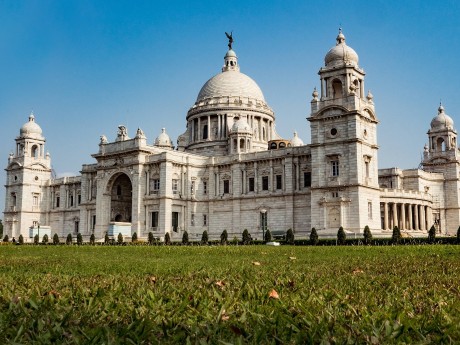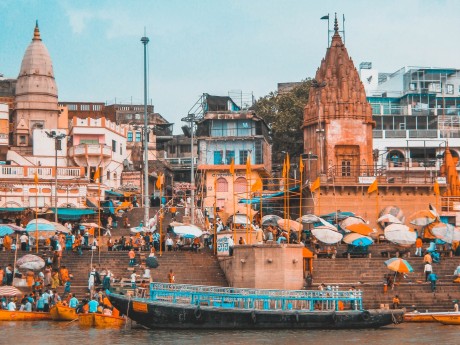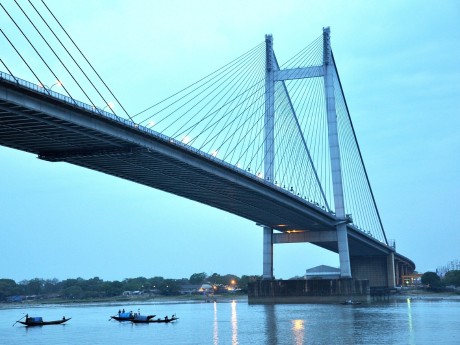India: Kolkata & Varanasi
Dive into the cultural heart of Kolkata and the spiritual soul of Varanasi. Witness colonial architecture, bustling markets, sacred temples, and the serene Ganges River. This trip promises a captivating blend of history, spirituality, and vibrant Indian life. Waterviews strives to offer accommodation options within walking distance of water and/or in an area of touristic interest. Our prices include taxes (but excludes local tourist taxes).
Read more
Dive into the cultural heart of Kolkata and the spiritual soul of Varanasi. Witness colonial architecture, bustling markets, sacred temples, and the serene Ganges River. This trip promises a captivating blend of history, spirituality, and vibrant Indian life. Waterviews strives to offer accommodation options within walking distance of water and/or in an area of touristic interest. Our prices include taxes (but excludes local tourist taxes). Customize your trip to your personal preferences with optional activities (hit the “Add Activities’’) or change hotels, etc. Contact us for customization at no extra cost at: Service@waterviewstravel.com
Destinations
- Kolkata
- Varanasi
Itinerary
Kolkata

A true city of contrasts, Kolkata (formerly Calcutta) is the capital of India’s West Bengal state that was once the country’s capital under the British Raj during the 18th century. Today, the city is known as India’s cultural, artistic and literary capital, and dazzles with its colonial-era architecture, excellent museums and vibrant festivals as well as its diverse culinary scene. Kolkata’s interesting attractions will draw you in, and its unique atmosphere will invite you to stay.
Read more
A true city of contrasts, Kolkata (formerly Calcutta) is the capital of India’s West Bengal state that was once the country’s capital under the British Raj during the 18th century. Today, the city is known as India’s cultural, artistic and literary capital, and dazzles with its colonial-era architecture, excellent museums and vibrant festivals as well as its diverse culinary scene. Kolkata’s interesting attractions will draw you in, and its unique atmosphere will invite you to stay.
Additional Information
History
Kolkata's history is intimately related to the British East India Company, which arrived in 1690, and to British India, of which Calcutta became the capital in 1772. Job Charnock was widely known as the founder of Calcutta. There were 3 villages named Sutanuti, Gobindopur & Kalikata. Later the village Kalikata became the city Kolkata. But some Indian historians have disputed this claim, arguing that Kolkata developed naturally over a period, centred on the ancient Kali temple at Kalighat and the port at Khidderpore.
Whatever its origins, Kolkata flowered as the capital of British India during the 19th century, the heyday of the Raj. Calcutta University, the first modern Indian university was founded here in 1857. Kolkata became the centre of Indian arts and literature, and the national movement for independence got its start here. However, with the transfer of the capital to Delhi in 1911, the pains of the partition of Bengal in 1947, a violent repressive and feudal state machinery operational for nearly the first two decades after independence, the ideologically motivated Maoist movement (the Naxalbari movement) in the 1970s, followed by the Marxist rule has shaped the city to its present form.
Modern Kolkata
Kolkata has become the main business, commercial and financial hub of eastern India. The city's economic fortunes grew as the economic liberalisation in India during the early 1990s reached Kolkata during late 1990s. Kolkata is a multicultural and cosmopolitan city, with diversity from all over India as well as Europeans (including Germans, Armenians, and others) and other Asians (including Chinese, Sinhalese, and Tibetans). Kolkata is also notable for being home to India's largest Chinatown, which continues to be home to many ethnic Chinese residents whose families have lived in India for several generations.
In 1977, a "Left Front" coalition of the Communist and Marxist parties came to power and ruled the state for 34 years. This is reflected in street names and memorials in the city with names like Lenin Sarani and Ho Chi Minh Sarani. During this period, the various egalitarian approaches implemented at improving the living standards of the down-trodden has helped the city in bridging the wealth-gap and decreasing impoverishment.
Economy
Kolkata is fast developing into a modern infotech city with various private sector companies setting up shops here. The landscape of the city is also fast changing with flyovers, gardens and several new commercial establishments. Kolkata city has expanded into its suburbs, with the Greater Kolkata stretching from Kalyani (in Nadia District) in north to Jaynagar Majilpur in south (in the South 24 Parganas District).
The city's fortunes have looked up since the early 1990s, coinciding with the liberalisation of the Indian economy. Its economy has been amongst the fastest growing in the country. The New Metro city is characterised by popular spots such as multiplexes, theatres, clubs, pubs, coffee shops, and museums.
Kolkata is home to many industrial units, of large Indian corporations, whose product range is varied and includes engineering products, electronics, electrical equipment, cables, steel, leather, textiles, jewellery, frigates, automobiles, railway coaches and wagons.
Several industrial estates like Taratala, Uluberia, Dankuni, Kasba, and Howrah are spread throughout the urban agglomeration. A huge leather complex has come up at Bantola. An export processing zone has been set up in Falta. Specialised setups like the country's first Toy Park, and a Gem and Jewellery Park have also been established.
Kolkata is also starting to become a major hub for the IT (Information Technology) industry. With the formation of New Town at Rajarhat and extension of Salt Lake's Sector-V, Kolkata is rapidly turning into a pro-IT town.
Geography
Kolkata is in the eastern part of India and is spread along the banks of the Hooghly river.
The Kolkata Municipal Corporation has an area of 185 km². The city can be roughly divided into two sections along Mother Teresa Sarani (which was known during English rule as Park Street). North of Park Street is the more congested part of the city. South of Park Street is the slightly better planned section of the city. South Kolkata is better planned with wider roads and better equipped police force for keeping law & order. The better planning in South Kolkata is because it was built much later. The North is the real, old Kolkata and most of the oldest families and buildings are situated there. Over the past several years the city has expanded to the south and the east.
The old Central Business District (CBD) is where the seat of the West Bengal Government is located, along with many other government offices. Several banks have their corporate or regional headquarters around the B.B.D. Bagh area (named after the revolutionaries Binoy, Badol and Dinesh who forced entry into The Writer's Building, the epicentre of the Raj government in West Bengal. Many of Kolkata's older business groups have their main offices here. The area is a mix of multi-storeyed office blocks and colonial buildings.
The newer CBD is around the south of Park Street, Camac Street and AJC Bose Road. Several high-rise office blocks including some of Kolkata's tallest commercial buildings, like the Chatterjee International Centre, Tata Centre, Everest House, Industry House, CGO Building, are located here. An even-newer CBD is now being set up in the Rajarhat (Newtown) area, lying between Salt Lake and the Airport.
Maidan (meaning open field) is between the river Ganges and J.L. Nehru Road (or Chowringhee). It is said to be the lungs of Kolkata. The lush green meadow also houses Victoria Memorial, Eden Gardens, and several sporting clubs. Kolkatans simply love to stroll in the Maidan.
In an effort to relieve congestion in the main city, many government offices have shifted to high-rise office buildings lining Bidhan Nagar's (Salt Lake) Central Park.
The residential buildings are mainly low-rise and comprise of older colonial buildings and numerous new four-storied apartment blocks. 10- to 12-storied apartment blocks have come up in large numbers in south Kolkata. The city has relaxed its rules on high-rise construction and 20-storey buildings are becoming more common. The tallest residential towers of eastern India, the four 35-storey towers of South City, are on Prince Anwar Shah Road.
Heavy construction activity along the Eastern Metropolitan Bypass is changing the face of the city. Luxury hotels, a convention centre, speciality hospitals, condominium complexes, malls and multiplexes are coming up at a rapid pace. The city's expansion in the eastern side is spearheaded by the construction of a large new city called New Town adjacent to the well planned Bidhan Nagar. Located in Rajarhat, it is one of the largest planned urban developments in India. The neglected western side of the urban agglomeration has got a boost with the signing of an agreement with Chiputra, an Indonesian company to build the Kolkata West International City (KWIC). Another huge new township is in the proposal state in Dankuni.
Slums and dilapidated structures exist in many pockets of the city proper and house over 25% of the city's population (Census 2001). Slum redevelopment schemes have helped improve living conditions by a small extent but there is huge scope for improvement in this area. Efforts to shift slum dwellers to newer developments have often met with resistance and failure because many of the slums are in prime areas of the city and the slum dwellers who are integrated in the social structure of the neighbourhood do not want to shift.
Many roads in Kolkata have two names in use: the old colonial name that is still commonly used by locals, and the official post-independence new name that you will see in maps and on road signs.
Climate
Kolkata has three main seasons: summer, monsoon, and winter. Summer, from March–May, is hot and humid with temperatures touching 38-42° Celsius. Monsoon starts in June and lasts till September or October. This is the time when heavy showers sometimes lead to water logging in a few areas. Winter is from November to February. This is the best season to visit the city, as the weather is very pleasant with temperatures ranging between 8 and 20°.
Time
Kolkata is in the GMT+5:30 time zone.
© Sourced from Wikivoyage
Varanasi

Located on the banks of the Ganges in Uttar Pradesh, magical Varanasi is the spiritual capital of India and the holiest of Hinduism’s seven sacred cities. The city also played an important role in the development of Buddhism; Buddha is believed to have founded Buddhism here in around 528 BC. Varanasi is one of the world’s oldest continually inhabited cities, and today attracts pilgrims who come to bathe in the sacred waters of the Ganges or even to cremate their loved ones.
Read more
Located on the banks of the Ganges in Uttar Pradesh, magical Varanasi is the spiritual capital of India and the holiest of Hinduism’s seven sacred cities. The city also played an important role in the development of Buddhism; Buddha is believed to have founded Buddhism here in around 528 BC. Varanasi is one of the world’s oldest continually inhabited cities, and today attracts pilgrims who come to bathe in the sacred waters of the Ganges or even to cremate their loved ones.
Additional Information
This mystical city attracts visitors who come for an encounter with the divine: legend has it that anyone who dies here will receive salvation in the form of Moksha (liberation from the endless cycle of birth and death).
This colourful, chaotic and emotionally challenging destination may just turn out to be your favourite destination of them all. Most visitors agree that it is a magical place which will live long in your memory, but it is not for the faint-hearted: the most intimate rituals of life and death are celebrated in public and the sights, sounds and smells in and around the Ghats can be overwhelming. The Ghats are probably the most typical and fascinating sites of Varanasi: literally embankments made in steps of stone along the river Ganges where pilgrims perform rituals.
Varanasi has also been known at various times in history as Kashi (City of Live) and it is, in fact, one of the oldest continuously inhabited city of the world. Pilgrims come to the River Gange to wash away a lifetime of sins in the sacred waters, as well as to cremate their loved ones. The Old City is situated along the western bank of the Ganges and extends behind ghats in a fascinating labyrinth of alleys, often too narrow for traffic.





